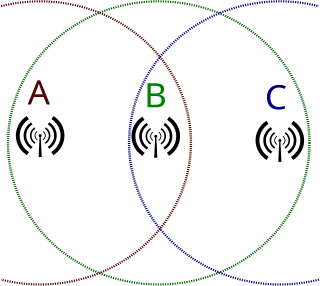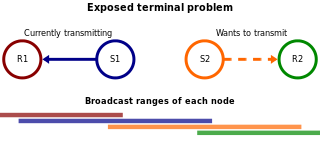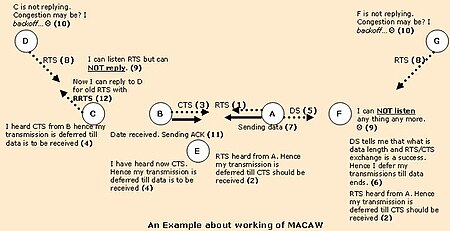
IEEE 802.11 is part of the IEEE 802 set of local area network (LAN) technical standards, and specifies the set of medium access control (MAC) and physical layer (PHY) protocols for implementing wireless local area network (WLAN) computer communication. The standard and amendments provide the basis for wireless network products using the Wi-Fi brand and are the world's most widely used wireless computer networking standards. IEEE 802.11 is used in most home and office networks to allow laptops, printers, smartphones, and other devices to communicate with each other and access the Internet without connecting wires. IEEE 802.11 is also a basis for vehicle-based communication networks with IEEE 802.11p.

Carrier-sense multiple access with collision avoidance (CSMA/CA) in computer networking, is a network multiple access method in which carrier sensing is used, but nodes attempt to avoid collisions by beginning transmission only after the channel is sensed to be "idle". When they do transmit, nodes transmit their packet data in its entirety.
Carrier-sense multiple access with collision detection (CSMA/CD) is a medium access control (MAC) method used most notably in early Ethernet technology for local area networking. It uses carrier-sensing to defer transmissions until no other stations are transmitting. This is used in combination with collision detection in which a transmitting station detects collisions by sensing transmissions from other stations while it is transmitting a frame. When this collision condition is detected, the station stops transmitting that frame, transmits a jam signal, and then waits for a random time interval before trying to resend the frame.

In IEEE 802 LAN/MAN standards, the medium access control (MAC), also called media access control, is the layer that controls the hardware responsible for interaction with the wired or wireless transmission medium. The MAC sublayer and the logical link control (LLC) sublayer together make up the data link layer. The LLC provides flow control and multiplexing for the logical link, while the MAC provides flow control and multiplexing for the transmission medium.
A controller area network is a vehicle bus standard designed to allow microcontrollers and devices to communicate with each other. It is a message-based protocol, designed originally for multiplex electrical wiring within automobiles to save on copper, but it can also be used in many other contexts. For each device, the data in a frame is transmitted serially but in such a way that if more than one device transmits at the same time, the highest priority device can continue while the others back off. Frames are received by all devices, including by the transmitting device.
IEEE 802.11e-2005 or 802.11e is an approved amendment to the IEEE 802.11 standard that defines a set of quality of service (QoS) enhancements for wireless LAN applications through modifications to the media access control (MAC) layer. The standard is considered of critical importance for delay-sensitive applications, such as voice over wireless LAN and streaming multimedia. The amendment has been incorporated into the published IEEE 802.11-2007 standard.
Distributed coordination function (DCF) is the fundamental medium access control (MAC) technique of the IEEE 802.11-based WLAN standard. DCF employs a carrier-sense multiple access with collision avoidance (CSMA/CA) with the binary exponential backoff algorithm.

In wireless networking, the hidden node problem or hidden terminal problem occurs when a node can communicate with a wireless access point (AP), but cannot directly communicate with other nodes that are communicating with that AP. This leads to difficulties in medium access control sublayer since multiple nodes can send data packets to the AP simultaneously, which creates interference at the AP resulting in no packet getting through.
IEEE 802.15.4 is a technical standard which defines the operation of a low-rate wireless personal area network (LR-WPAN). It specifies the physical layer and media access control for LR-WPANs, and is maintained by the IEEE 802.15 working group, which defined the standard in 2003. It is the basis for the Zigbee, ISA100.11a, WirelessHART, MiWi, 6LoWPAN, Thread, Matter and SNAP specifications, each of which further extends the standard by developing the upper layers which are not defined in IEEE 802.15.4. In particular, 6LoWPAN defines a binding for the IPv6 version of the Internet Protocol (IP) over WPANs, and is itself used by upper layers like Thread.
RTS/CTS is the optional mechanism used by the 802.11 wireless networking protocol to reduce frame collisions introduced by the hidden node problem. Originally the protocol fixed the exposed node problem as well, but modern RTS/CTS includes ACKs and does not solve the exposed node problem.
Exponential backoff is an algorithm that uses feedback to multiplicatively decrease the rate of some process, in order to gradually find an acceptable rate. These algorithms find usage in a wide range of systems and processes, with radio networks and computer networks being particularly notable.

In wireless networks, the exposed node problem occurs when a node is prevented from sending packets to other nodes because of co-channel interference with a neighboring transmitter. Consider an example of four nodes labeled R1, S1, S2, and R2, where the two receivers are out of range of each other, yet the two transmitters in the middle are in range of each other. Here, if a transmission between S1 and R1 is taking place, node S2 is prevented from transmitting to R2 as it concludes after carrier sense that it will interfere with the transmission by its neighbor S1. However note that R2 could still receive the transmission of S2 without interference because it is out of range of S1.
In data communications, flow control is the process of managing the rate of data transmission between two nodes to prevent a fast sender from overwhelming a slow receiver. Flow control should be distinguished from congestion control, which is used for controlling the flow of data when congestion has actually occurred. Flow control mechanisms can be classified by whether or not the receiving node sends feedback to the sending node.
Selective Repeat ARQ or Selective Reject ARQ is a specific instance of the automatic repeat request (ARQ) protocol used to manage sequence numbers and retransmissions in reliable communications.
Ethernet Powerlink is a real-time protocol for standard Ethernet. It is an open protocol managed by the Ethernet POWERLINK Standardization Group (EPSG). It was introduced by Austrian automation company B&R in 2001.
Multiple access with collision avoidance (MACA) is a slotted media access control protocol used in wireless LAN data transmission to avoid collisions caused by the hidden station problem and to simplify exposed station problem.
Vehicular Reactive Routing protocol (VRR) is a reactive routing protocol with geographical features which is specifically designed for Wireless Access for the Vehicular Environment (WAVE) standard in vehicular ad hoc networks (VANETs). The protocol takes advantages of the multichannel scheme defined in WAVE and uses the Control Channel (CCH) for signalling, and relies on one of the multiple Service Channels (SCHs) for payload data dissemination.
The link layer is the lowest layer in the TCP/IP model. It is also referred to as the network interface layer and mostly equivalent to the data link layer plus physical layer in OSI. This particular layer has several unique security vulnerabilities that can be exploited by a determined adversary.
NACK-Oriented Reliable Multicast (NORM) is a transport layer Internet protocol designed to provide reliable transport in multicast groups in data networks. It is formally defined by the Internet Engineering Task Force (IETF) in Request for Comments (RFC) 5740, which was published in November 2009.
Sensor Media Access Control(S-MAC) is a network protocol for sensor networks. Sensor networks consist of tiny, wirelessly communicating computers, which are deployed in large numbers in an area to network independently and as long as monitor their surroundings in group work with sensors, to their energy reserves are depleted. A special form of ad hoc network, they make entirely different demands on a network protocol and therefore require network protocols specially build for them (SMAC). Sensor Media Access Control specifies in detail how the nodes of a sensor network exchange data, controls the Media Access Control (MAC) to access the shared communication medium of the network, regulates the structure of the network topology, and provides a method for synchronizing.





